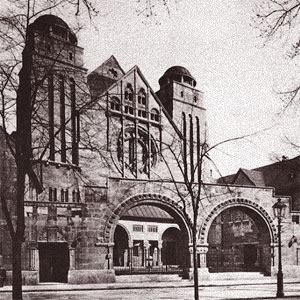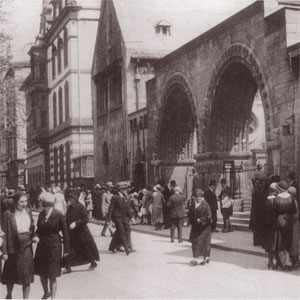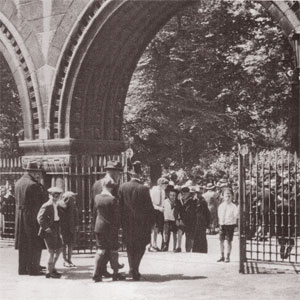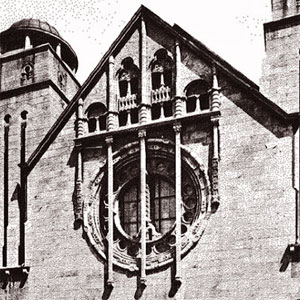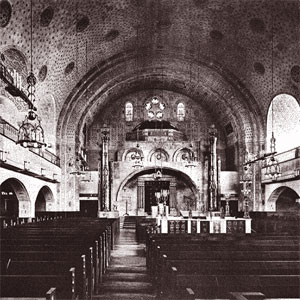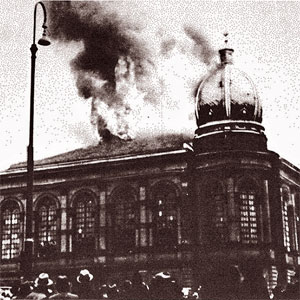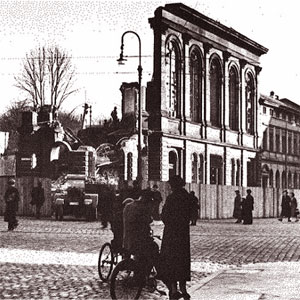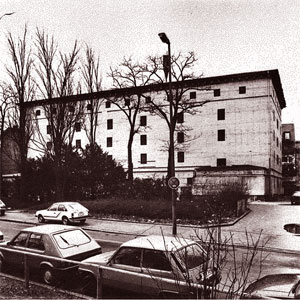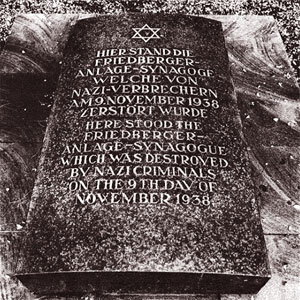Concert and Reading for the Re-opening of the Exhibition
“Ostend – View of a Jewish Quarter”
April 28, 2013, 11:00am
At the site of the former synagogue of the Israeli religious community in the bunker (Hochbunker), Friedberger Anlage 5 – 6, 60314 Frankfurt am Main
An event from the “Initiative 9. November e. V.”
We bring you the opportunity to hear a reading and a tonal musical performance.The texts, connected to this very location, are stories by Jewish and non-Jewish Frankfurters alike, which we find to be an utterly fitting act of remembrance on the 75th anniversary of the destruction of that Jewish community, who had the centre of their faith on this very ground. How those former events are seen in the light of personal experience, always adds a new accent to what is known, and shows them to be interminable, and it is precisely as narratives they are alive and remain part of the present. We have invited the One Earth Orchestra not solely due to its association with Klezmer music, but because its musical understanding is grounded in the idea of the richness of polyphonic cultural life, and can be heard as a protest against all that is dull and, ultimately, destructively monolithic, which is not least represented by this bunker here.
Prof. Dr. Hans-Peter Niebuhr
Chairman of the “Initiative 9. November e. V.”
Programme
Volker Staub (1961): OEO # 1 and # 2 (2012)
for flute, clarinet, cello, accordion, percussion
Alfred Oppenheimer: The inauguration of the synagogue.
Alfred Rosenthal: I have asked myself with every person I have met: Where have you been, what have you done?
Cilly Peiser: The synagogue later became a bunker.
Georgina Derbez Roque (1968): Symphony (2006)
for solo accordion
Walter Rust: Our florists did well due to our Jewish customers.
Rose Teichert: Don’t talk to me – if someone were to see!
Yehuda Ariel: It wasn’t a mob that burnt the synagogue down.
Volker Staub: Weiche Gesänge Nr. 26 Part III (1994-97)
for solo steel string
Volker Staub: OEO #3 (2012)
for flute, clarinet, cello, accordion, percussion
Volker Staub: Weiche Gesänge Nr. 26 Part I (1994-97)
for solo steel string
Christine Hermann: Children, get up, they set fire to the synagogue!
Benjamin Hirsch: The destruction of the synagogue.
Inge Hess: I was so ashamed to be German.
Ruben Staub (1992): Klezmer Medley (2012-13)
for solo clarinet
Emil Mai: Life on the sidelines.
Edith Erbrich: As children we already had to be adults.
Volker Staub: OEO # 4, to a Parambikulam melody, OEO # 5
for flute, clarinet, cello, accordion, percussion
Music: One Earth Orchestra
with Lea Polanski: Flute, Ruben Staub: Clarinet, Larissa Nagel: Cello
Eva Zöllner: Accordion, Stefan Kohmann: Percussion
Volker Staub: Steel Strings and Artistic Direction
Reading: Petra Fehrmann, Günther Henne
All texts from: Initiative 9. November e.V. “Erinnerung braucht Zukunft – Der Ort der zerstörten Synagoge an der Friedberger Anlage in Frankfurt am Main”, Brandes & Apsel Publishing House, Frankfurt 2010.
Biographies
Petra Fehrmann
is an actress, presenter and moderator. For many years she has acted at the State Theatre Heidelberg and in countless independent theatre productions. She is frequently appears in television productions. Since 2000 she has been working as a presenter and moderator at Hessen Radio (Hessischer Rundfunk).
Günther Henne
is an actor. After drama and vocal training he appeared in various productions at Unterhaus Mainz, the Fritz Rémond Theater in Frankfurt, Schnawwl Mannheim, the Munich Touring Theatre, at the Frankfurt Opera and in Hessischer Rundfunk’s radio plays. Parallel to these guest appearances he has been involved in almost all Theaterhaus productions and the founding of the Theaterhaus ensemble in 2000.
Volker Staub
studied piano and composition. He has composed 107 pieces in almost all genres and developed interdisciplinary performances. Since 1981 he has been inventing and building experimental musical instruments and sound installations, which he often uses in his own work in conjunction with traditional instruments and singing. His works have been awarded 13 national and international prizes.
Alfred Oppenheimer
born in 1914, sadly no further biographical information is known.
Alfred Rosenthal
was born in 1913 in Hamburg. In 1933 he emigrated to Palestine and worked there as the Siemens representative in Tel Aviv, working his way up from footboy to the executive management. After returning to Germany, he became involved in the Society for Christian-Jewish Cooperation (Gesellschaft für Christlich-Jüdische Zusammenarbeit) at the Leo Baeck Institute and at the Franz Oppenheimer Society. In 1996 he received the Federal Cross of Merit for his outstanding work in the fields of interfaith understanding and reconciliation.
Cecily Peiser
was born in 1925 as Cecily Levitus in Frankfurt. After the death of her father, her mother found a job and board at the Jewish orphanage in Röderbergweg. After the November Pogrom Cecily Peiser was evacuated with her younger sister and other children to the Netherlands and lived there hidden by Dutch Christians, and survived the German occupation and the war. In 1946, after the war, she stowed away on a ship to Palestine.
Walter Rost
born in 1925 in Frankfurt and grew up in Sandweg 6. His family owned a large florists there from 1922 to 1993.
Rose Teichert
born in 1923, she grew up with her seven siblings in Ostend. Before the Nazi period her family owned several houses near the zoo and her grandfather and father owned a company which employed ten staff. She attended Junior High School in Ostend and later undertook an apprenticeship in nursing .
Yehuda Ariel
born in Oppenheim, Frankfurt, presumably at the end of the First World War. With his family, who belonged to the Jewish religious community, he was able to emigrate to Palestine.
Christine Herrmann
née Hau, experienced as a 15 year old the destruction of the synagogue of the Jewish religious community in 1938; she was the youngest daughter of Justin Haus, the castellan of the synagogue, and lived with her parents and three siblings in this building.
Benjamin Hirsch
born in 1932 in Frankfurt, the fifth of seven children to the dentist Dr. Hermann Hirsch and his wife Mathilde, today he lives as an architect in Atlanta, Georgia, USA. There he established amongst others the Holocaust Memorial of Atlanta. His parents and his younger siblings were deported from Frankfurt and murdered.
Inge Hess
bookseller, born in 1931, lived until 1958 in Sandweg 29. Her father, a trade unionists with close links to the SPD, was unemployed until 1938, before working as a type founder at the Bauerschen Foundry. Her mother was chemical factory worker, working in a chemical plant in Fechenheim.
Emil Mai
born in 1928 in Frankfurt. His Jewish father came from a part of Galicia, which was part of Austria-Hungary and belonged to Poland after the First World War. Emil Mai’s family was affected by the so called Polish-Operation in Autumn 1938, when his father and sister were deported to Poland. He himself was later taken to the Theresienstadt ghetto (also known as the Theresienstadt concentration camp), and was one of the survivors.
Edith Erbrich
born in 1937, was according to Nazi jargon a “half-breed of the first degree”. She spent her first seven years in Ostend, until she was deported together with her sister, who was four years her elder, and her father to Theresienstadt in February 1945. Only after her return in the summer of 1945, was she able to attend school.
© Images: Photos 1 and 5: Jewish Museum, Frankfurt; Photos 2, 3 and 4: Institut für Stadtgeschichte Frankfurt; Photos 8 and 9: Initiative 9. November e.V.

